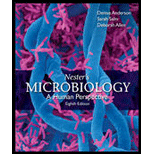
Concept explainers
What are the major differences between a prokaryotic cell and a eukaryotic cell?
To review:
The differences between prokaryotic and eukaryotic cell.
Introduction:
The key difference between the prokaryotes and eukaryotes is known to be the most vital difference between the groups of various organisms. The eukaryotic cells comprisemembrane-bound structures like the nucleus, whereas the prokaryotic cells do not consist of this. The differences among prokaryotic and eukaryotic cellular structure also includes the presence of the cell wall, mitochondria, chloroplasts, and the chromosomal DNA (deoxyribonucleic acid) structure.
Explanation of Solution
| Eukaryotic cell | Prokaryotic cell |
| Nucleus is present. | Nucleus is absent. |
| Chromosomes are more in number. | Only one chromosome is present, which is not a true chromosome and is known as plasmids. |
| It is multicellular. | Unicellular. |
| The truemembrane-bound nucleus ispresent in it. | It is absent. |
| Animals as well as the plants are classified as the eukaryotic cells. | Bacteria and archaea are eukaryotic cells. |
| Meiosis as well as the fusion of the gametes leads to the recombination of genes | Partial recombination. |
| Lysosomes and peroxisomes are present. | It is absent. |
| Microtubules are present. | It is rare or absent. |
| Mitochondria are present. | Absent. |
| Histones wrap the DNA. | Multiple proteins work together to fold and wrap the DNA. |
| Large ribosomes. | Small ribosomes. |
Therefore, it can be concluded that eukaryotic and prokaryotic cells are different from one another and the prime difference is the structure of the two cells.
Want to see more full solutions like this?
Chapter 12 Solutions
Nester's Microbiology: A Human Perspective
- What symbolic and cultural behaviors are evident in the archaeological record and associated with Neandertals and anatomically modern humans in Europe beginning around 35,000 yBP (during the Upper Paleolithic)?arrow_forwardDescribe three cranial and postcranial features of Neanderthals skeletons that are likely adaptation to the cold climates of Upper Pleistocene Europe and explain how they are adaptations to a cold climate.arrow_forwardBiology Questionarrow_forward
- ✓ Details Draw a protein that is embedded in a membrane (a transmembrane protein), label the lipid bilayer and the protein. Identify the areas of the lipid bilayer that are hydrophobic and hydrophilic. Draw a membrane with two transporters: a proton pump transporter that uses ATP to generate a proton gradient, and a second transporter that moves glucose by secondary active transport (cartoon-like is ok). It will be important to show protons moving in the correct direction, and that the transporter that is powered by secondary active transport is logically related to the proton pump.arrow_forwarddrawing chemical structure of ATP. please draw in and label whats asked. Thank you.arrow_forwardOutline the negative feedback loop that allows us to maintain a healthy water concentration in our blood. You may use diagram if you wisharrow_forward
- Give examples of fat soluble and non-fat soluble hormonesarrow_forwardJust click view full document and register so you can see the whole document. how do i access this. following from the previous question; https://www.bartleby.com/questions-and-answers/hi-hi-with-this-unit-assessment-psy4406-tp4-report-assessment-material-case-stydu-ms-alecia-moore.-o/5e09906a-5101-4297-a8f7-49449b0bb5a7. on Google this image comes up and i have signed/ payed for the service and unable to access the full document. are you able to copy and past to this response. please see the screenshot from google page. unfortunality its not allowing me attch the image can you please show me the mathmetic calculation/ workout for the reult sectionarrow_forwardIn tabular form, differentiate between reversible and irreversible cell injury.arrow_forward
 Biology (MindTap Course List)BiologyISBN:9781337392938Author:Eldra Solomon, Charles Martin, Diana W. Martin, Linda R. BergPublisher:Cengage Learning
Biology (MindTap Course List)BiologyISBN:9781337392938Author:Eldra Solomon, Charles Martin, Diana W. Martin, Linda R. BergPublisher:Cengage Learning Concepts of BiologyBiologyISBN:9781938168116Author:Samantha Fowler, Rebecca Roush, James WisePublisher:OpenStax College
Concepts of BiologyBiologyISBN:9781938168116Author:Samantha Fowler, Rebecca Roush, James WisePublisher:OpenStax College Human Biology (MindTap Course List)BiologyISBN:9781305112100Author:Cecie Starr, Beverly McMillanPublisher:Cengage Learning
Human Biology (MindTap Course List)BiologyISBN:9781305112100Author:Cecie Starr, Beverly McMillanPublisher:Cengage Learning
 Biology 2eBiologyISBN:9781947172517Author:Matthew Douglas, Jung Choi, Mary Ann ClarkPublisher:OpenStax
Biology 2eBiologyISBN:9781947172517Author:Matthew Douglas, Jung Choi, Mary Ann ClarkPublisher:OpenStax Biology Today and Tomorrow without Physiology (Mi...BiologyISBN:9781305117396Author:Cecie Starr, Christine Evers, Lisa StarrPublisher:Cengage Learning
Biology Today and Tomorrow without Physiology (Mi...BiologyISBN:9781305117396Author:Cecie Starr, Christine Evers, Lisa StarrPublisher:Cengage Learning





